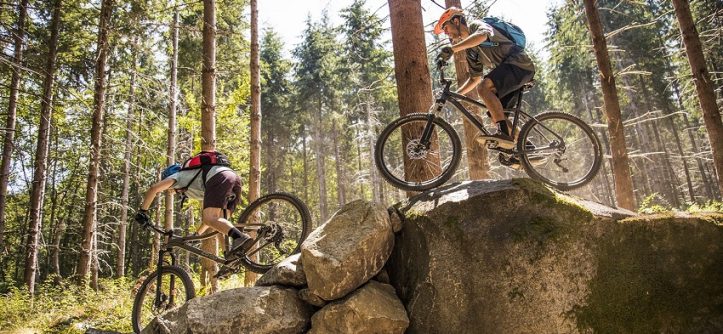Mountain biking can be a fun and rewarding outdoor activity, but it can also be challenging and dangerous if you’re not properly prepared. This guide will provide you with information on how to train for mountain biking so that you can safely enjoy this sport. Tips covered include how to improve your strength and endurance, how to practice safe riding techniques, and how to select the right gear for your needs. Whether you’re a beginner or an experienced rider, following these tips will help you get the most out of your mountain biking experience.
How to train for mountain biking?
Mountain bike training is different than training for other cycling disciplines like road or track racing. The main difference is that you need to focus on strength and endurance, as well as skills like balance and agility. Here are some tips for how to train for mountain biking:
- Improve your strength and endurance. In order to ride up steep hills and navigate challenging terrain, you need to be strong and have good endurance. To improve your strength, do exercises like squats, lunges, and push-ups. To improve your endurance, ride a stationary bike or go for long walks or hikes.
- Practice safe riding techniques. One of the biggest dangers in mountain biking is losing control and crashing. To minimize your risk of crashing, practice safe riding techniques like braking and turning. Make sure you’re comfortable with these techniques before hitting the trails.
- Select the right gear. When it comes to mountain biking, having the right gear can make a big difference. Make sure you have a bike that’s suited for your riding style and the terrain you’ll be riding in. Also, invest in high-quality helmets and pads. This will help you ride safely and comfortably when exploring the great outdoors.
- Stay hydrated. Dehydration is a common problem among mountain bikers, especially during hot weather. Make sure you drink plenty of fluids before, during, and after your rides.
- Take breaks. When riding in challenging terrain, it’s important to take breaks often to rest and refuel. Don’t try to push yourself too hard or you’ll end up getting tired and injured.
- Practice balance and agility. In order to navigate tight corners and obstacles, you need good balance and agility. To improve your balance, try standing on one leg for a minute or two. To improve your agility, do exercises like jumping jacks or sprints.
- Join a mountain biking club. Riding with a group of friends will keep you motivated and improve your riding skills. In addition, you can share gear and have someone to cheer you on when you’re feeling tired or sore after a ride.
- Ride with the right group of people. When going out for a mountain bike ride, make sure that you bring a group of people who are at the same skill level as you. If you ride with a group of beginners, you’ll end up frustrated and bored. And if you ride with a group of experts, you’ll get left behind and may not be able to keep up.
- Take lessons from a pro. If you’re new to mountain biking, taking lessons from a pro is the best way to learn proper techniques and gain confidence in your riding abilities.
- Ride when the weather conditions are safe. Avoid mountain biking when it’s dark or raining, which can cause you to lose focus and control your bike more easily.
- Practice riding up steep hills. If you want to be an advanced mountain biker, you need to be able to ride up steep hills without losing control of your bike. This requires good strength and strong leg muscles. To practice this, find a steep hill that’s safe to ride on, then ride up it over and over again.
- Invest in a good mountain bike. You can easily find the best mountain bikes under 1000. If you’re serious about mountain biking, it’s important to invest in a good mountain bike. This will ensure that you have a bike that’s suited for the terrain you’ll be riding in and that will last for years.
- Take your time. Don’t try to tackle difficult trails or hills until you’ve mastered the basics. You’ll have a much more enjoyable experience if you learn how to ride properly on less challenging trails first.
- Wear the right gear. When riding your bike, make sure you wear high-quality helmets and pads to minimize your risk of injury. Also, avoid wearing shorts or jeans that might get caught in the chain.
- Know when to stop. If you feel pain or discomfort, don’t keep riding through it. Take a break and rest until your pain is gone before hitting the trails again.
- Practice turning and braking on flat ground. Before you start riding on uneven terrain, practice turning and braking on flat ground so that you can get a feel for how it works.
- Spend time on other kinds of trails before tackling tougher ones. Scrambling and climbing can be fun, but beginners should start out on easier trails so they can get the hang of riding properly before moving onto more difficult terrain.
- Look up trail maps and reviews online before riding in a new area. Mountain biking is about having fun and staying safe, and the best way to do that is by learning as much as you can about a trail before riding it.
- Watch videos of other people mountain biking online. This will help motivate you and give you an idea of how advanced riders handle tough terrain.
- Read up on mountain biking tips and techniques. The more you know about mountain biking, the better prepared you’ll be to tackle difficult trails and improve your riding skills.
Conclusion
It is important to train on different terrains. If you are training for mountain biking, make sure that you do not only focus on the terrain in which you will be competing. This type of one-dimensional thinking can lead to overuse injuries and lack of physical preparation when it comes time to race. Make sure that your workouts include a variety of downhill runs, uphill climbs, paved roads, dirt paths, and open fields so that all areas of your body get used equally during these types of exercises. Your goal should always be injury prevention before anything else!




